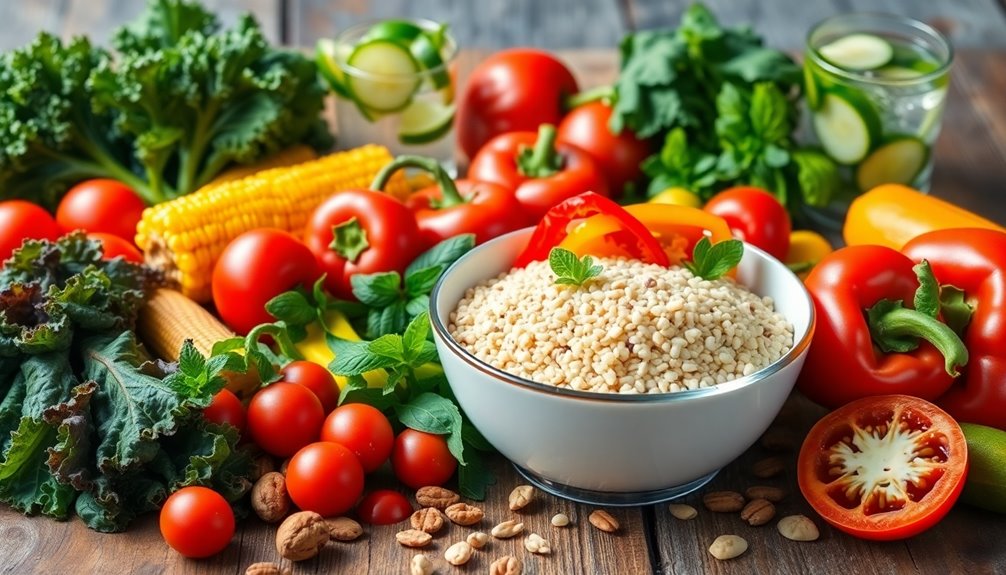The DASH diet, or Dietary Approaches to Stop Hypertension, is designed to help you lower blood pressure and enhance heart health. You'll focus on whole foods like fruits, vegetables, lean proteins, and whole grains while minimizing sodium and unhealthy fats. Incorporate plenty of colorful produce and opt for low-fat dairy options. Avoid processed foods high in sodium, sugary drinks, and red meats. The benefits are significant, including improved heart health and weight loss. With practical strategies and flexible options, you can easily adopt this diet for lasting health improvements. Stick around to uncover more about getting started and succeeding with DASH.
Key Takeaways
- The DASH diet is designed to lower blood pressure and promote heart health through a focus on whole foods and nutrient-rich ingredients.
- It emphasizes the consumption of fruits, vegetables, whole grains, lean proteins, and low-fat dairy while reducing sodium and unhealthy fats.
- Benefits of the DASH diet include improved heart health, weight loss, enhanced nutrient intake, and a lower risk of chronic diseases.
- The diet is flexible, accommodating various dietary preferences and cultural cuisines, making it easier to incorporate into daily life.
- Supported by scientific research and health organizations, the DASH diet promotes long-term health benefits like reduced cholesterol and decreased inflammation.
What Is the DASH Diet?
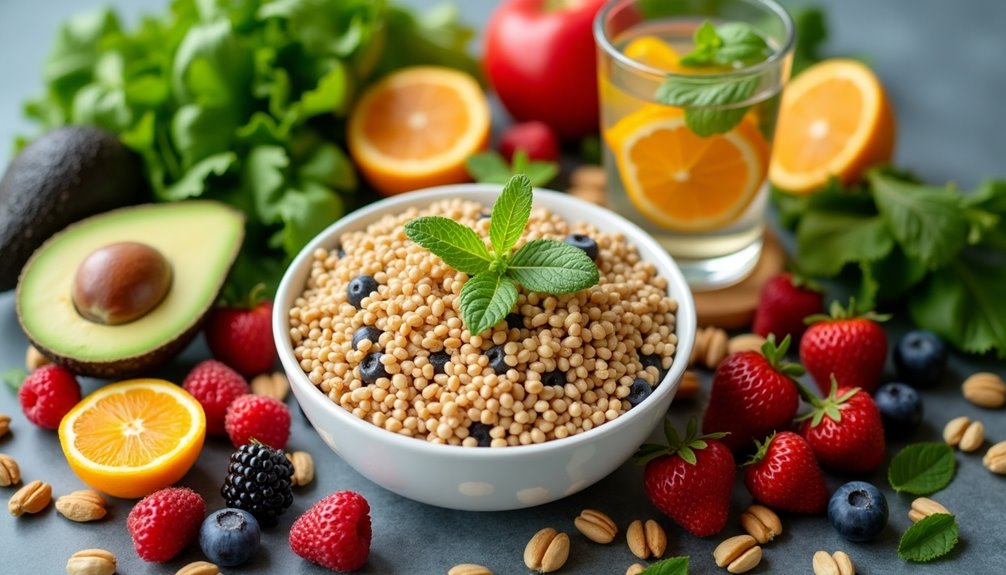
The DASH diet, which stands for Dietary Approaches to Stop Hypertension, is a proven eating plan designed to help lower blood pressure and promote overall heart health. This diet emphasizes whole foods, such as fruits, vegetables, whole grains, lean proteins, and low-fat dairy, while reducing sodium and unhealthy fats. By adopting the DASH diet, you'll likely experience several benefits, including improved heart health, weight loss, and enhanced nutrient intake. These advantages make it an appealing choice for many looking to embrace a healthier lifestyle.
However, like any diet, there are some drawbacks to take into account. For instance, while the DASH diet is effective in reducing hypertension, it may require more meal prep and planning compared to more flexible eating patterns. Additionally, some individuals may find it challenging to adjust their taste preferences, especially if they're used to a diet high in processed foods.
In terms of effectiveness, numerous studies support the DASH diet's role in significantly lowering blood pressure levels. This diet's emphasis on nutrient-rich foods contributes to its long-term sustainability, as it encourages habits you can maintain over time rather than short-term restrictions. In addition to dietary changes, incorporating mind/body exercises can further enhance blood pressure management and overall cardiovascular health.
Ultimately, the DASH diet offers a robust framework for those seeking to enhance their health. It fosters a sense of community, as many people share similar goals of better heart health. Embracing this eating plan can lead to lasting benefits, helping you feel connected to a larger movement toward wellness.
Key Principles of the DASH Diet
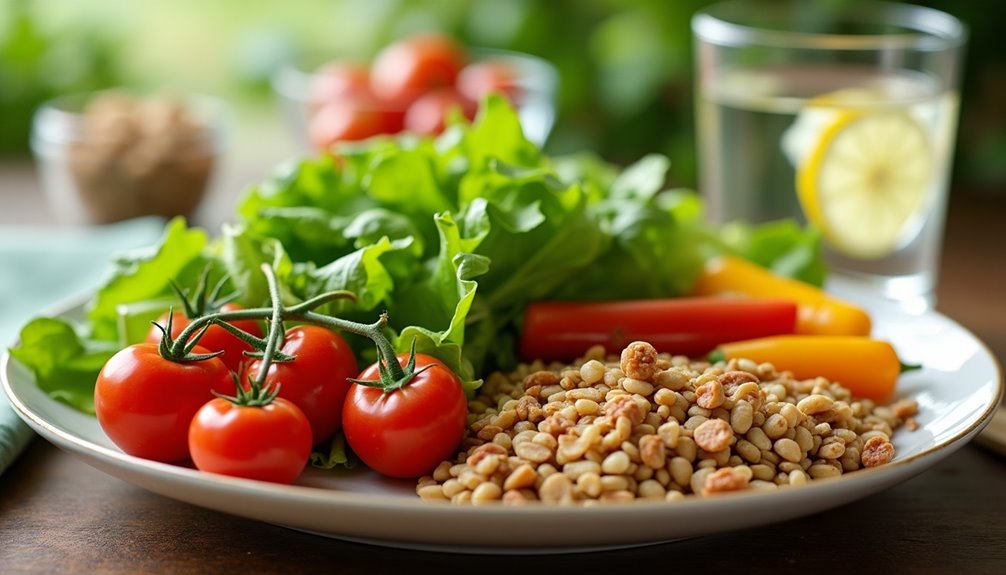
Consistently following the key principles of the DASH diet can lead to significant improvements in your health. This diet emphasizes whole foods, balanced meals, and smart hydration habits. By focusing on nutrient-rich options, you'll not only manage your blood pressure but also enhance your overall well-being. Additionally, incorporating plant-based foods can further support your health and well-being.
Here's a quick overview of the key principles to keep in mind:
| Principle | Description | Tips for Implementation |
|---|---|---|
| Whole Grains | Choose brown rice, quinoa, and whole wheat. | Incorporate these in your meal prep. |
| Fruits and Vegetables | Aim for at least 4-5 servings of each daily. | Create colorful salads and snacks. |
| Lean Proteins | Include fish, poultry, beans, and nuts. | Prepare protein-rich meals in advance. |
| Low-Fat Dairy | Opt for yogurt and skim milk. | Substitute cream with yogurt in recipes. |
| Healthy Fats | Use olive oil, avocados, and nuts. | Add nuts to salads for a nutritious boost. |
Meal prep is essential for success with the DASH diet. Planning your meals ahead helps you stick to these principles, making it easier to grab healthy options on busy days. Also, don't forget about your hydration habits. Drinking enough water is vital, so keep a water bottle handy and set reminders to stay on track. By adopting these principles, you'll cultivate a healthier lifestyle and enjoy the benefits of the DASH diet.
Foods to Include

Incorporating a variety of nutrient-dense foods is essential for the success of the DASH diet. This approach emphasizes whole grains, fruits, vegetables, lean proteins, and low-fat dairy. By including these foods, you'll not only manage your blood pressure but also boost your overall health.
Start with whole grains like brown rice, quinoa, and whole wheat bread. They're high in fiber and help keep you full. Fill your plate with colorful fruits and vegetables—think berries, oranges, spinach, and broccoli. These are packed with vitamins, minerals, and antioxidants. Aim for at least five servings a day to reap the benefits.
Lean proteins such as chicken, turkey, fish, and plant-based options like beans and lentils are great choices. They provide essential amino acids without the added saturated fat found in red meats. Incorporating low-fat dairy products like yogurt and cheese can also give you the calcium and vitamin D your body needs. Additionally, consider adding protein-packed vegan smoothies to your diet to enhance your nutrient intake and support weight loss.
When meal prepping, consider using flavorful substitutes for salt. Herbs and spices like garlic, lemon juice, and cumin can enhance your dishes without increasing sodium. You'll find that experimenting with different flavors makes healthy eating enjoyable and satisfying.
Foods to Avoid

To effectively follow the DASH diet, restricting certain foods that can undermine your health goals is crucial. One of the biggest culprits is excessive salt intake. Processed foods often contain an abundance of sodium, which can elevate your blood pressure and counteract the benefits of the DASH diet. You'll want to scrutinize labels and steer clear of products with more than 140 mg of sodium per serving.
Consider common processed foods you might've in your pantry. Items like canned soups, frozen meals, and deli meats can be saturated with salt. Instead, opt for fresh or frozen vegetables without added sauces, and consider cooking from scratch when you can. This way, you can manage the salt content and make healthier choices.
Another category to be wary of is sugary beverages and snacks. Sodas, sweetened teas, and even some fruit juices can contribute to weight gain and elevated blood pressure. Instead, hydrate with water or unsweetened beverages.
Lastly, restrict red meats and full-fat dairy products. These can be rich in saturated fats, which aren't in line with the DASH principles. Try swapping them with lean proteins like chicken or fish, and opt for low-fat dairy alternatives. Additionally, adopting dietary strategies similar to those outlined in Diabetes Freedom may help improve overall health and support blood pressure management.
Health Benefits of DASH Diet
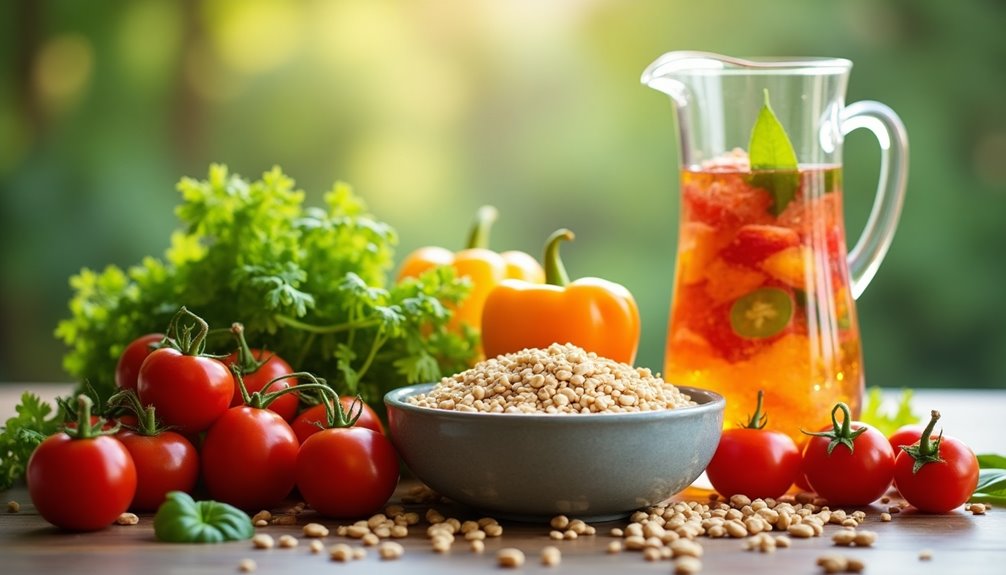
Embracing the DASH diet can lead to a multitude of health benefits that directly support your well-being. One of the most significant advantages is its positive impact on heart health. By focusing on whole foods, like fruits, vegetables, lean proteins, and whole grains, you're nourishing your body with essential nutrients that promote cardiovascular wellness. Research shows that people who follow the DASH diet often experience lower cholesterol levels and a reduced risk of heart disease.
Another key benefit is its effectiveness in managing blood pressure. The DASH diet emphasizes reducing sodium intake while increasing potassium-rich foods, which are known to help regulate blood pressure. Studies indicate that individuals who adopt this eating pattern can see significant improvements in their blood pressure readings within just a few weeks. This is especially important if you're looking to maintain healthy blood pressure levels over time.
Additionally, the DASH diet encourages a balanced approach to eating, which can lead to weight loss and better overall health. By prioritizing nutrient-dense foods, you'll likely feel full and satisfied, making it easier to resist unhealthy snacks. This sense of community around healthy eating can foster a supportive environment where you feel inspired to make lasting changes. Adopting this diet can also complement other health plans, such as a custom keto diet plan, which emphasizes personalized nutrition strategies.
Incorporating the DASH diet into your life not only enhances your heart health and blood pressure but also cultivates a lifestyle that values nourishment and well-being. You're not just following a diet; you're joining a movement towards better health.
Sample Meal Plan
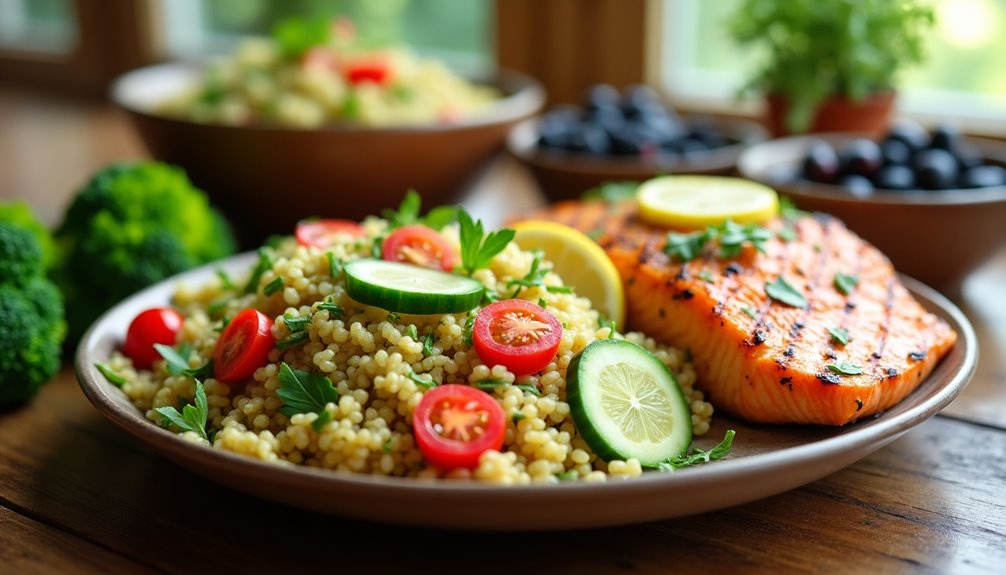
When developing a DASH diet meal plan, you'll want to focus on a variety of nutrient-rich foods that can easily fit into your daily routine. Start your day with a breakfast that includes whole grains, like oatmeal topped with fresh fruit and a sprinkle of nuts.
For lunch, consider a salad packed with leafy greens, colorful veggies, and a lean protein such as grilled chicken or chickpeas.
For dinner, you might enjoy a stir-fry made with brown rice, a mix of your favorite vegetables, and tofu or lean beef. Don't forget to incorporate healthy snacks throughout the day—think hummus with carrot sticks or a small handful of almonds.
When it comes to grocery shopping, aim for the perimeter of the store where fresh produce, dairy, and meats are typically located. Fill your cart with a variety of fruits, vegetables, whole grains, and legumes. This not only supports your DASH diet goals but also makes meal preparation easier and more enjoyable.
You'll find plenty of recipe ideas online that can help you create delicious and satisfying meals. Explore options that excite your palate while adhering to DASH principles. Remember, variety is key to keeping your meals interesting and preventing boredom. With thoughtful planning and a well-stocked pantry, you'll be well on your way to enjoying the benefits of the DASH diet while also feeling a sense of community and belonging in your health journey. Additionally, incorporating lifestyle changes can significantly aid in managing underlying health conditions that contribute to chronic kidney disease.
Tips for Success

Staying committed to the DASH diet can be easier with some practical strategies in place. One effective approach is meal prep. By taking a few hours each week to plan and prepare your meals, you can guarantee that healthy options are readily available. Chop vegetables, cook grains, and portion out snacks in advance. This not only saves time during busy weekdays but also helps you resist the temptation of unhealthy choices when hunger strikes.
Another key strategy is practicing mindful eating. This means paying full attention to your food and the experience of eating, rather than rushing through meals. When you slow down and savor each bite, you're more likely to appreciate the flavors and textures of the nutrient-rich foods that the DASH diet encourages. This can also help you recognize when you're full, preventing overeating. Additionally, understanding the importance of natural calorie cycles can further enhance your ability to maintain a balanced and healthy eating pattern.
Incorporate these habits into your daily routine, and you'll likely find it easier to adhere to the DASH diet. Connect with others who share your commitment—join a community group or find a friend to exchange recipes and meal ideas. Sharing your journey can provide motivation and accountability, making the process enjoyable and less isolating.
DASH Diet and Weight Loss
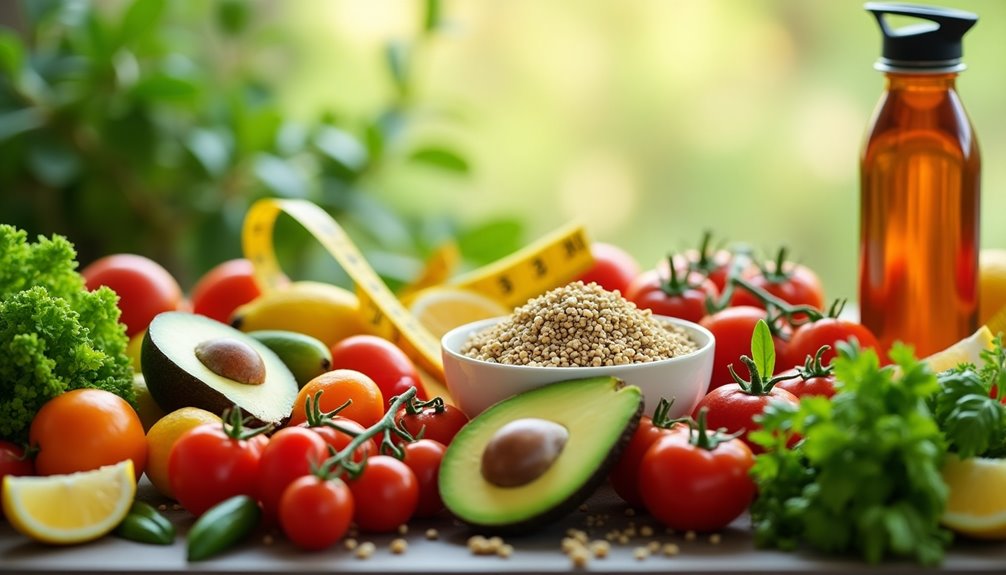
The DASH diet isn't solely focused on reducing blood pressure; it can also be a potent tool for weight loss. By emphasizing nutrient-rich foods and advocating for calorie restriction, you can shed those excess pounds while enhancing your overall health. The DASH diet promotes filling your plate with fruits, vegetables, whole grains, and lean proteins, making it simpler to manage your caloric intake without feeling deprived. Additionally, delicious, easy-to-make recipes can help maintain interest and enjoyment in your meals throughout your weight loss journey.
To optimize your weight loss journey, pairing the DASH diet with a consistent exercise routine is crucial. Regular physical activity enhances metabolism and complements your body's calorie-burning efforts. Here's a basic overview of how the DASH diet can complement an exercise regimen:
| Food Categories | Serving Size | Physical Activity Time (weekly) |
|---|---|---|
| Fruits and Vegetables | 4-5 servings each | 150 minutes of moderate activity |
| Whole Grains | 6-8 servings | Strength training 2 days per week |
| Lean Proteins | 2 or fewer servings | Flexibility exercises 2 days per week
Common Misconceptions
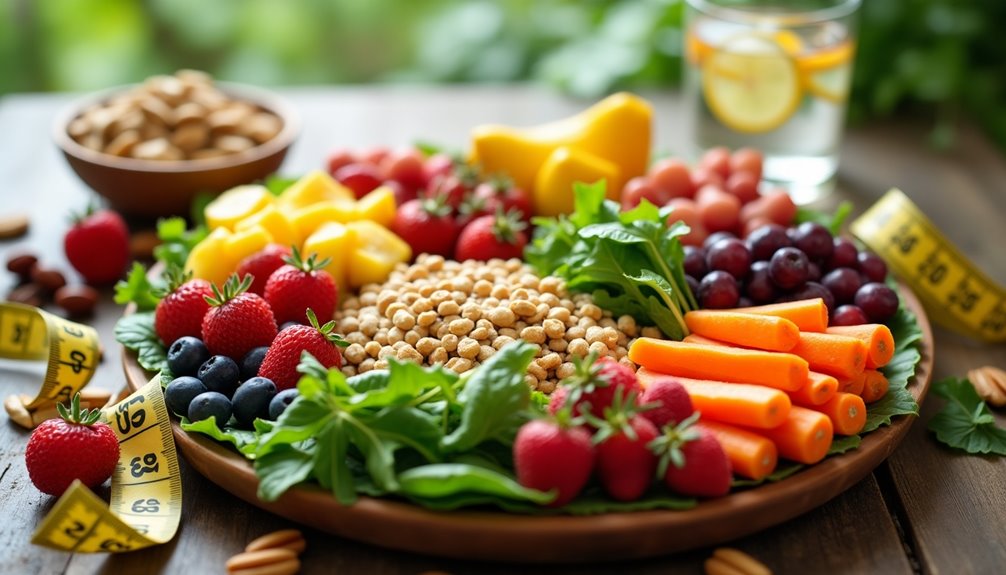
While the DASH diet is celebrated for its benefits in weight loss and blood pressure management, several misconceptions can cloud its effectiveness.
One common myth is that the DASH diet means you can't enjoy any salt. In reality, the diet encourages reducing salt consumption but doesn't eliminate it entirely. It promotes a balanced approach, allowing you to season your food while being mindful of your overall sodium intake. Research shows that moderate salt consumption can fit within the DASH framework without compromising its advantages.
Another misconception is that the DASH diet is only for those with high blood pressure. While it's designed to help manage and lower high blood pressure, anyone looking to improve their overall health can benefit from it. The emphasis on whole foods, fruits, vegetables, and lean proteins makes it an excellent choice for anyone wanting to enhance their diet.
Some people also believe that the DASH diet is overly restrictive and complicated. However, it's more about making smarter choices rather than following strict guidelines. You can enjoy a variety of foods, making it easier to stick with in the long run.
Lastly, many think that following the DASH diet alone will instantly lower blood pressure. While it's a powerful tool, combining it with regular physical activity and other healthy lifestyle choices is essential for the best results. Embracing the DASH diet can lead to meaningful changes in your health and well-being when you understand these misconceptions. Additionally, those who consume a diet rich in whole foods may experience improved gut health, further supporting overall well-being.
Getting Started With DASH

Getting started with the DASH diet is easier than you might think. By focusing on whole foods and balanced meals, you can make simple changes that lead to significant health benefits.
To kick things off, consider your grocery shopping habits. Start by creating a list that includes plenty of fruits, vegetables, whole grains, lean proteins, and low-fat dairy products. Aim for variety; colorful plates not only look good but also provide essential nutrients.
When you're at the store, stick to the perimeter where fresh produce and proteins are typically located. Avoid processed foods found in the middle aisles, as they often contain high levels of sodium and added sugars that can counteract your efforts. Additionally, incorporating plant-based diets can further enhance your heart health and overall well-being.
Next, meal prep is your best friend. Set aside a couple of hours each week to prepare healthy meals and snacks. Chop vegetables, cook grains, and portion out servings of protein. This not only saves time during the week but also helps you stay on track. When healthy options are readily available, you're less likely to reach for unhealthy alternatives.
Frequently Asked Questions
Can Children Follow the DASH Diet Safely?
Yes, children can safely adopt a balanced diet that highlights fruits, vegetables, whole grains, and lean proteins. You can include nutritious snacks like yogurt or fresh fruit in their school lunches to maintain their energy levels and promote their growth. It's crucial to make sure they receive the proper nutrients while making meals enjoyable. Engaging them in meal preparation can also nurture a sense of belonging and promote healthy eating habits.
Is the DASH Diet Suitable for Vegetarians and Vegans?
Yes, the DASH diet can absolutely suit vegetarians and vegans! You'll find plenty of plant-based options that align with its principles. Focus on whole grains, fruits, and vegetables while incorporating protein sources like beans, lentils, tofu, and nuts. These foods not only provide essential nutrients but also support heart health. By emphasizing diverse plant-based choices, you can enjoy a balanced diet that meets your needs and keeps you feeling great.
How Long Does It Take to See Results on the DASH Diet?
You might see noticeable results from lifestyle changes in as little as two weeks. Research shows that adopting healthier eating habits can lower blood pressure by about 5-10% within this timeframe. While these initial changes are promising, the long-term benefits really shine through after several months of consistent efforts.
Sticking with it not only improves your health but also fosters a sense of belonging within supportive communities focused on wellness and nutrition.
Are There Any Supplements Recommended While on the DASH Diet?
While you're focusing on your dietary choices, you might wonder about supplement recommendations to support your nutrient balance. Generally, a well-rounded diet should provide most nutrients, but if you're considering supplements, look for options like potassium or magnesium, especially if your intake is low.
Always consult with a healthcare professional before adding supplements, as they can help tailor recommendations based on your specific needs while ensuring you maintain a healthy nutrient balance.
Can the DASH Diet Be Adapted for Food Allergies?
When it comes to food allergies, adapting your diet can feel like finding your way through a maze. You can definitely make allergy modifications to fit your needs. Think about ingredient substitutions that maintain the diet's core principles while avoiding allergens.
For example, swap dairy for almond milk or choose gluten-free grains. By tailoring the plan to suit your allergies, you'll not only protect your health but also embrace a nourishing lifestyle that welcomes everyone.
Conclusion
Incorporating the DASH diet into your life isn't merely a meal plan; it's a culinary revolution that could transform your health overnight! By embracing nutrient-rich foods and ditching the unhealthy options, you'll feel like a superhero, prepared to conquer the world with boundless energy and essentiality. The health benefits are nothing short of miraculous—lower blood pressure, weight loss, and enhanced well-being. So, immerse yourself in DASH and watch your life change in ways you never thought possible!

